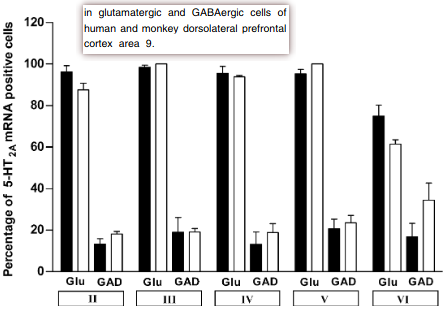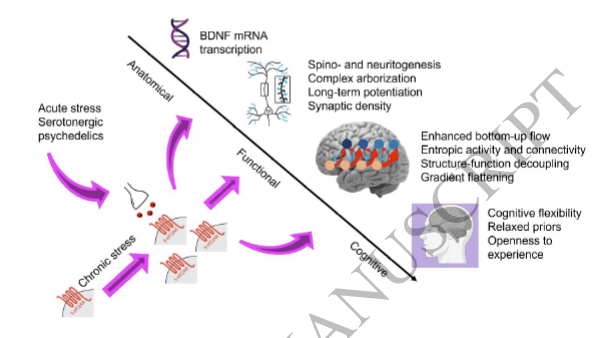5-HT2A
links: reference: https://neuroskeptic.blogspot.com/2011/12/psychedelic-tale-of-two.html
- Looks very informative: Central serotonin-2A (5-HT2A) receptor dysfunction in depression and epilepsy: the missing link
- https://www.reprocell.com/blog/biopta/5ht2a-serotonin-receptor 4-27-2021
5-HT2A #
-
Gq-coupled.
-
Can be activated by Dopamine??
-
Mediates psychedelia, anxiety, inhibits Locus Coeruleus NE release, elicits glutamate release from the PFC, dopamine in the PFC, bladder contraction ?
-
-

- So yeah in layer II-V of the Dorsolateral Prefrontal Cortex, it is coexpressed with almost all glutamatergic and GABAergic neurons.
-
-
Density decreases by 1% each year of lifespan
-
Increases prefrontal acetylcholine?
-
[Cortical serotonin 5-HT2A receptor binding and social communication in adults with Asperger’s syndrome: an in vivo SPECT study]
- People with Asperger’s syndrome had a significant reduction in cortical 5-HT2A receptor binding in the total, anterior, and posterior cingulate; bilaterally in the frontal and superior temporal lobes; and in the left parietal lobe. Also, reduced receptor binding was significantly related to abnormal social communication.
-
The activation of 5-HT2A receptors in prefrontal cortex enhances dopaminergic activity (i.e. D2)
-
Psychedelic visuals probably = disinhibition of Thalamus.
-
Psychedelics promote neuroplasticity through the activation of intracellular 5-HT2A receptors (Feb 2023) ( Sheekey science show video)
-
Psychedelics and Other Psychoplastogens for Treating Mental Illness
- Psychoplastogens are charactezied by, after single treatment, sustained effects on structural plasticity, notably in the PFC! Which means more excitatory projections to decrease depressive behavior, addiction, etc.
- Pretty sure it’s from Gαq → Ca2+ → TrkB
-
Brain-Derived Neurotrophic Factor Signaling and Subgenual Anterior Cingulate Cortex Dysfunction in Major Depressive Disorder
- BDNF was not reduced in the aCC, but TrkB was, and thus various markers that are downstrean/dependent on BDNF, like SST, NPY, COST, Glutamate Decarboxylase 2, etc. (they note that GAD1 isn’t BDNF-dependent)
- Psychoplastogens are charactezied by, after single treatment, sustained effects on structural plasticity, notably in the PFC! Which means more excitatory projections to decrease depressive behavior, addiction, etc.
- Positive correlation between lipophilicity (thus able to pass the membrane, which serotonin is not capable of - notice the methylation on the amine with DMT/Psilocin, which serotonin does not have) and the psychoplastogenic effect, with DMT being the strongest.
- Clearly linked is a (mostly) inverse correlation between β-arrestin 2 Emax and Gq Emax and lipophilicity.
- The ability to pass through the membrane is significant due to the presence of intracellular 5-HT2A in cortical neurons.
- They gave the cells SERT, applied serotonin, and the dendritic outgrowth was similar to that of DMT.
- Related:
Interaction of psychedelic tryptamine derivatives with a lipid bilayer (Mar 2023)
- DMT and 5-MeO-DMT cross the membrane spontaneously during the simulation time, but bufotenine does not, although it has the maximum effect on the structural properties of the membrane. I guess
 dat hydroxy group is too polar:
dat hydroxy group is too polar:

- DMT and 5-MeO-DMT cross the membrane spontaneously during the simulation time, but bufotenine does not, although it has the maximum effect on the structural properties of the membrane. I guess
-
Psychedelics and Other Psychoplastogens for Treating Mental Illness
-
-
Glutamate #
-
Serotonin, via 5-HT2A receptors, increases EPSCs in layer V pyramidal cells of prefrontal cortex by an asynchronous mode of glutamate release #
